Disclosure: Meeple Mountain received a free copy of this product in exchange for an honest, unbiased review. This review is not intended to be an endorsement.
Finding a deserving pet their perfect home can be a challenge. As the purveyor of a feline adoption agency, nobody knows that better than you. Fortunately, over the course of your tenure in the field of human fur baby relations, you’ve learned a few tricks. It’s all about the marketing. The cuter the cat, the more attractive the display, the higher the likelihood a match will be made. And that always puts a smile on your face.
In the game of Way Too Many Cats, the players are managing Cat Adoption agencies. Each turn, the players will be drafting cats from a lineup and then adding them to their displays in an effort to score the most points by the game’s end. Each cat has some position-based scoring criteria. Some score extra points if you’ve given them what they like: certain cat toys or being kept in specific areas. And then there are the kittens. Collect a set and you’ll score extra points. Leave too many kittens ungrouped, though, and they’ll cost you a lot of points. There’s a lot to consider along the way. Will your adoption agency rise as the best or will you be left playing second fiddle?
Of course, this is a very high level overview of the game. If you’d like to learn how Way Too Many Cats is actually played, keep on reading. Otherwise, feel free to skip ahead to the Thoughts section to find out what I think of the game.
Adoption Agencies Activate!
The setup for a game of Way Too Many Cats looks something like this:
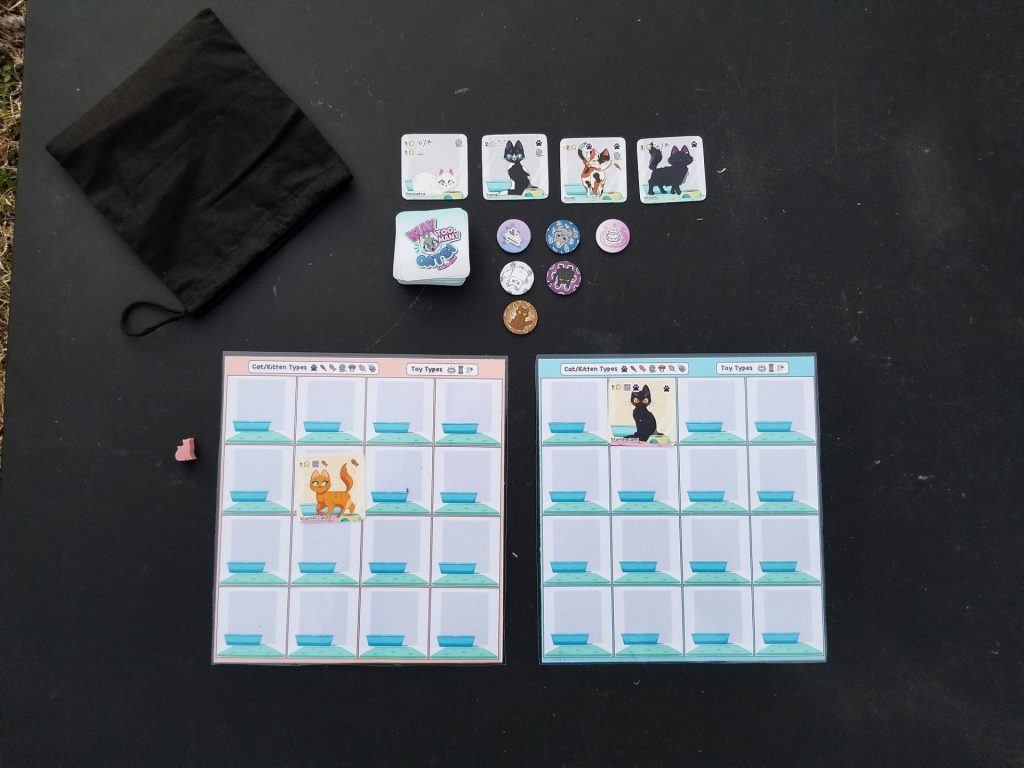
Each player begins with their own player board (divided into a grid), a player aid, and a Starter Cat card that they will have placed somewhere on their board. In between the players sits Cat Alley, composed of 4 face-up cards drawn randomly from the Cat card deck. Next to this are three rows of tokens drawn from the cloth bag: one row of three tokens, a row of two, and a row with a single token.
And that’s it for the setup. Choose a start player, give them the First Player marker, and you’re ready to go.
About Those Cats…
Each Cat card has a few things in common:
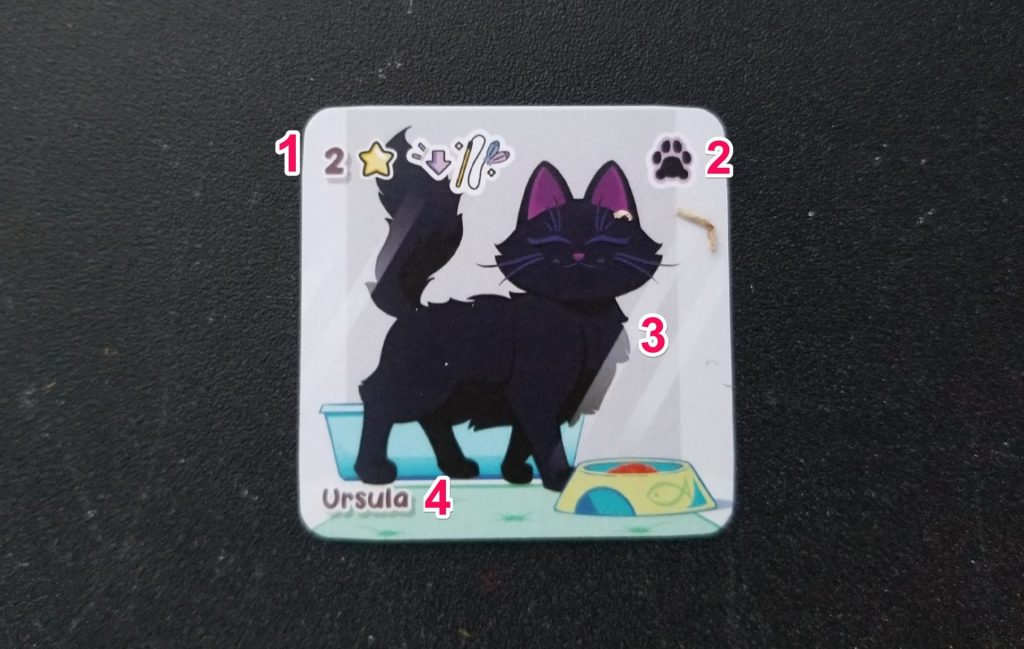
- A victory point condition: some cats are very fond of certain items, some will score (or cost you) points when placed in certain locations within your grid, and others score points for being placed next to cats of certain colors.
- A specific color denoted both by the color of the fur in the image as well as the icons. Some cats are multi-colored. This is important as each color scores differently at the end of the game.
- An illustration. As mentioned previously, each cat’s fur color(s) is/are associated with the icons in the top right of the card.
- A name. This is unimportant for the game play.
Each turn, the active player is going to be selecting some combination of cards and tokens from the display. Collected Cat cards must be placed into their grid and the tokens are set off to the side of it. Then the display gets refilled and the next player takes their turn.
…and Those Kittens
Kittens come in the form of tokens and there are seven distinct colors with their own unique icon backgrounds. These kittens will need to be managed, either collected in groups as sets of all seven types or groups of four-of-a-kind, or else they’re going to cost you points at the end of the game.
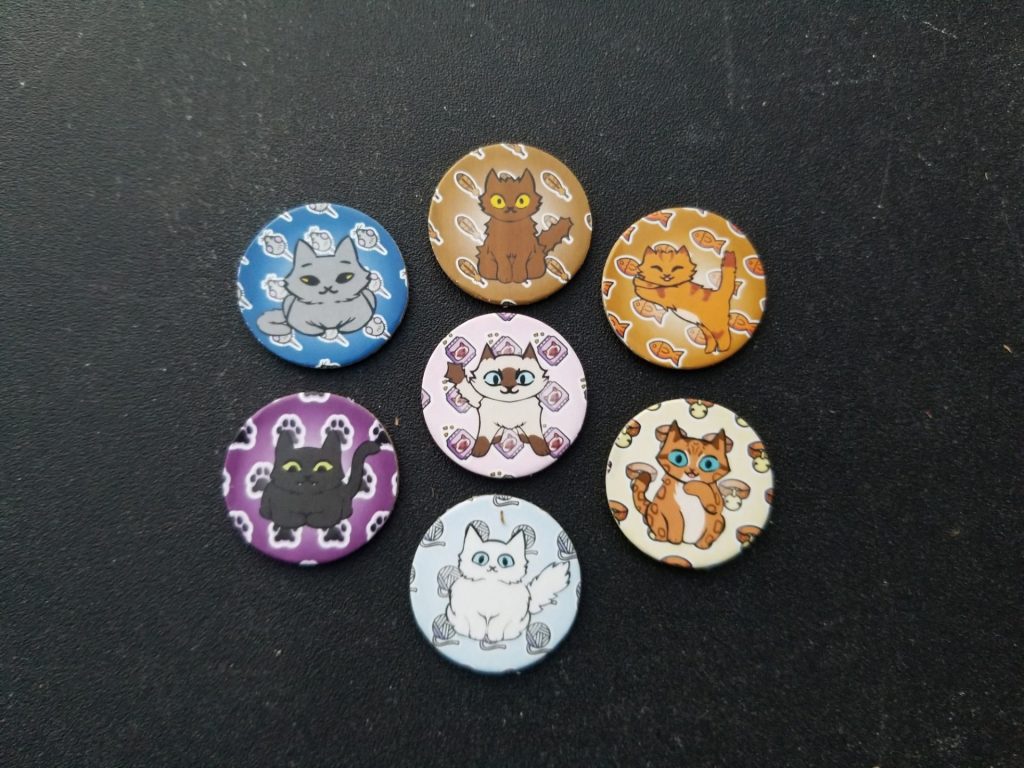
In addition to the Kitten tokens, there are also cat toys: a scratching post, a fancy bed, and a feather toy. These toys have two uses. Firstly, some Cat cards reward extra points if that cat is provided with a specific type of toy. At any time during the game, you can assign a toy to one of your placed cats. Secondly, if you find yourself with an overabundance of kittens and are looking at a lot of negative points, after collecting your Cat cards and tokens for the round, you can discard three cat toys to create a Kitten Habitat in your grid. Select an empty square and then place one to four Kitten tokens into it. These tokens will no longer cost you points at the end of the game and, while they don’t score anything, they will benefit the Cat cards that surround them as you’ll soon see.
Way Too Many Ways to Score
The game comes to an end once someone has completely filled in their grid and everyone has had the same number of turns. Then the final scores are tallied. And this is where things start to get confusing.
Firstly, each of the four cat types (yarn ball, feather, fish, and paw print) scores a different way. Yarn ball type cats score two points apiece. That’s pretty easy. Secondly, Feather type cats score more points the more of them there are in a single cluster. This one isn’t too difficult.

Fish type cats score two points for each orthogonally adjacent cat or kitten of the Yarn ball type up to a maximum of six points. Things are starting to get a little more confusing now. Since different cats can score different amounts of points, and there are potentially 16 different locations that this scoring can be applied to, that’s a lot of math to do in your head.
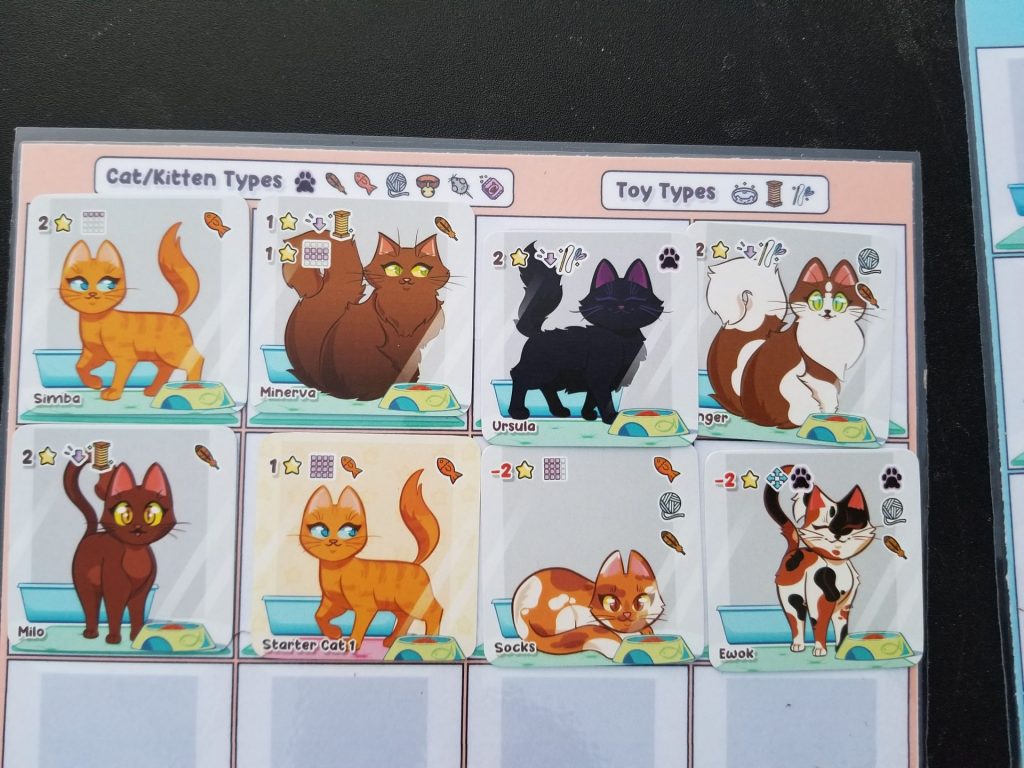
Lastly, the Paw Print type cats score a single point for each adjacent cat or kitten color (i.e. – different icons) up to a maximum of four points. This is the one that’s the most confusing as the different icons might be spread across several different bordering cats. Compound that with the varying scores across different cats (like the Fish type scoring) and it gets even worse. In one game I played, one of the players jokingly commented about how it takes longer to do the scoring than it does to play the game. While that’s a bit of an exaggeration, it’s not too far off the mark.
Each Cat card also has the potential to score bonus points as dictated by the criteria in the upper left hand corner of the card. These scoring criteria should be treated as if-then statements. IF the criteria on the right is true, THEN the player scores the points on the left. For instance:
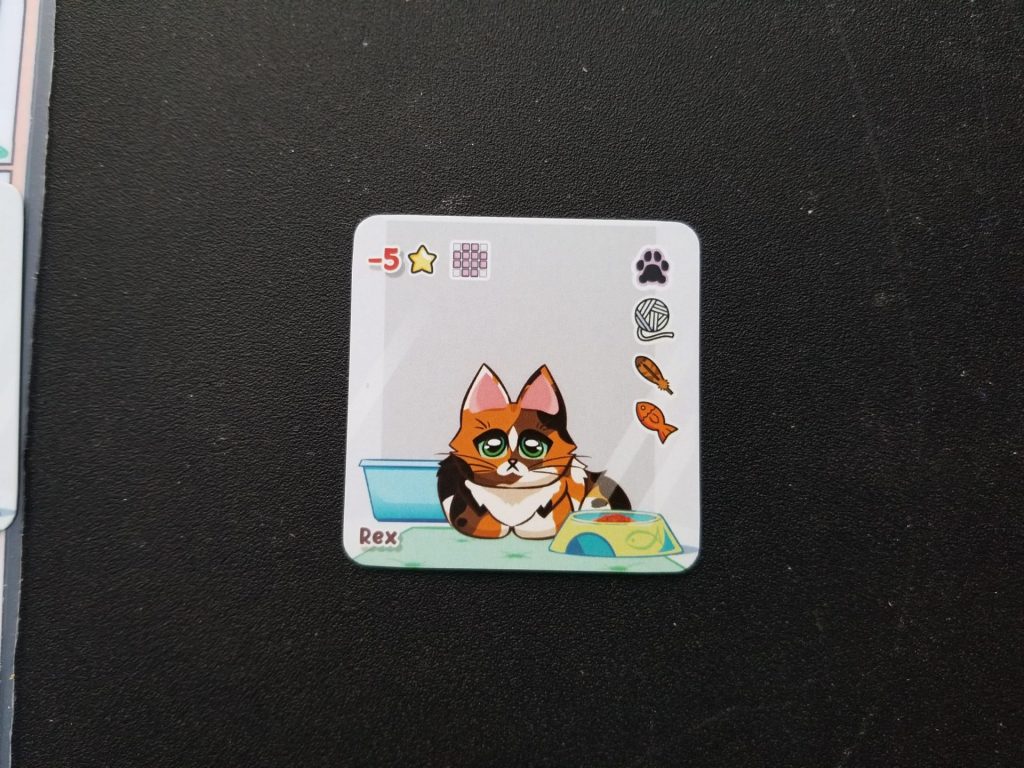
IF Rex is in the pink area, THEN it’s going to score you -5 points at the end of the game. So, you’d probably want to avoid placing that cat into any of the squares covered by that pink area.
Lastly, if you have a complete set of Kitten tokens, you’ll score 15 points for the set. If you have a collection of four kittens of the same type, that’s eight points. Kitten tokens not collected into a set or collection are worth -2 points apiece.
Thoughts
The day that Way Too Many Cats showed up on my radar I was sitting at the dining room table outside of my sister’s kitchen spreading peanut butter on Ritz crackers with my niece. It was a few days before Christmas and we’d gathered for our annual cookie making bonanza. Lost in the therapeutic release of the repetitive, mindless task of peanut butter spreading, I was startled out of my reverie when my phone suddenly started buzzing on the table close by. Overcoming the sudden shock, I turned my screen face up so that I could see what it was that had caused my phone to buzz. It was the Meeple Mountain Slack chat and our editor had just posted a list of review requests.
I quickly scrolled through the list to see if anything caught my eye that I thought would interest me, but I didn’t see anything that leapt out at me. The only game that even somewhat intrigued me was a small drafting game about cats. I knew my niece had really taken to the copy of Sushi Go that my wife and I had purchased for her and it stood to reason that she, being a cat person and a fan of Sushi Go, might be interested in this game. So, I asked her if she’d be willing to play it with me if I decided to accept the review copy. She readily agreed and I volunteered shortly thereafter.
Then everyone started getting sick with COVID and I haven’t gotten to spend any time with my niece since then. The upshot is that I took on Way Too Many Cats specifically to play with a person that I haven’t seen since I took it on in order to play it with her. I’d like to say that’s the most ironic thing about Way Too Many Cats, but it isn’t. The biggest irony is that the one audience this game is most suited for is probably the one audience that will struggle with it the most.
The game is very easy to set up and super easy to teach. Turns go by very smoothly as the actual gameplay is intuitive and uncomplicated. Pick up some cards and some tokens. Put the card into your grid. Rinse and repeat. Nothing hard about that.
No, the real problem is the scoring. It feels burdensome. Whatever fun you might have had during the course of playing the game fades away as soon as the end game is triggered. And it isn’t because any single scoring mechanism is overly complicated. It’s just that the sum of all of them added together becomes almost too much to bear.
At first I thought that maybe this impression was clouded by inexperience, but time after time, game after game, it’s been the same. The end game scoring brings everything to a grinding halt. People have stood up and walked away rather than stick around to figure out what their end total was. I think that Way Too Many Cats suffers from a lack of editing. There are just a few too many mechanics at play here. Take a look at a game like Ecosystem, for instance. Ecosystem shares a lot of things in common with Way Too Many Cats, but it’s a much more elegant and refined game. And in a world where games like Ecosystem exist, it’s hard for me to recommend Way Too Many Cats over any of those others.
If you don’t mind the convoluted scoring and if you’re a fan of cat games, then you might enjoy this one. But if either of those two things sounds unappealing, then this definitely isn’t the game for you. It’s a shame. I really wanted to like this game, but that end game just leaves me with a bad taste in my mouth and I can’t get over that. It’s a fine game, but just not the game for me. If they ever produce an app version of the game that handles the scoring, though, I’m all over it.


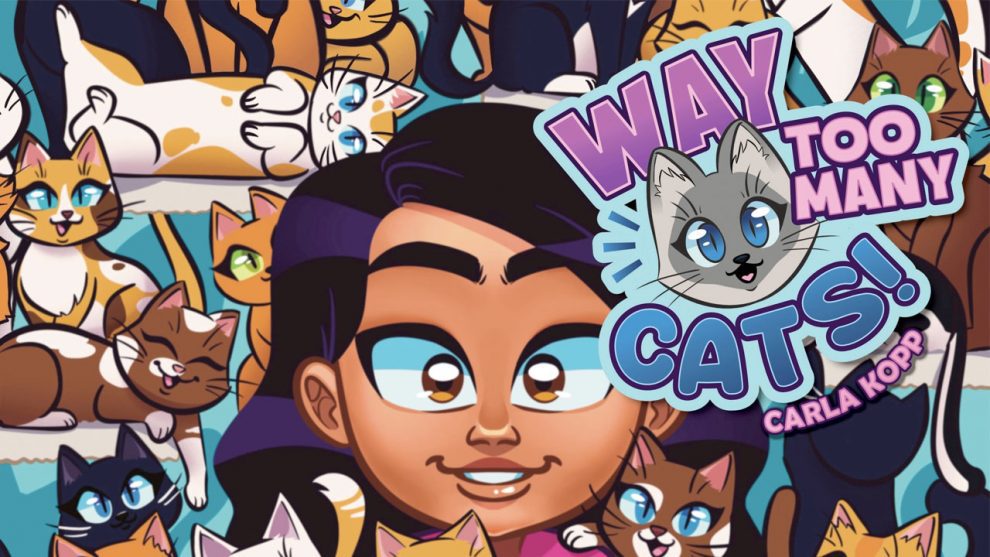








Add Comment